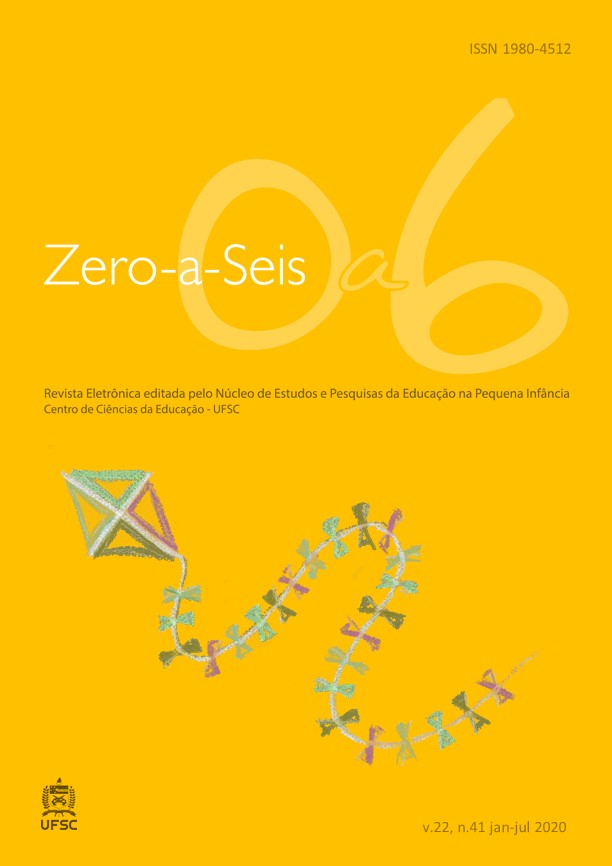Exploring kindergarten children's perception of spatial relations
DOI:
https://doi.org/10.5007/1980-4512.2020v22n41p204Abstract
This paper focuses on young children’s perception of spatial relations. It analyses spatial relations of kindergarten children (3-5-years-old, N=15), addressing two questions: How do children perform when solving perception of spatial relationships problems? What strategies do children use when solving these problems? Qualitative methods were used to describe children’s reactions when solving problems of: recognizing position from 2D to 3D, recognizing parts of the whole, recognizing the position of the objects. Results suggests that recognizing position from 2D to 3D seems to be the most difficult problems. Even 3-years-old used successful strategies in solving the perception of spatial relations problems. Thus these problems can be explored in kindergarten, as a way to stimulate visualization skills.
References
ALVES, Cristina; GOMES, Alexandra. Uma avaliação diagnóstica sobre a percepção de relações espaciais em crianças dos 3 aos 6 anos. In: ASSOCIAÇÃO DE PROFESSORES DE MATEMÁTICA (Ed.). Atas do XXIII seminário de investigação em educação matemática. Lisboa, 2011. p. 345-358.
ALVES, Cristina; GOMES, Alexandra. Perceção de relações no espaço por crianças dos 3 aos 7 anos. In: ASSOCIAÇÃO DE PROFESSORES DE MATEMÁTICA (Ed.). Atas do XXII seminário de investigação em educação matemática. Lisboa, 2012. p. 181-192.
ARCAVI, Abraham. The role of visual representations in the learning of mathematics. Educational studies in mathematics, 3, n. 52, p. 215-241, 2003.
BAROODY, Arthur; CLEMENTS, Douglas; SARAMA, Julie. Teaching and Learning Mathematics in Early Childhood Programs. In: CHRISTOPHER P. BROWN, M. B. M. A. N. F. (Ed.). The Wiley Handbook of Early Childhood Care and Education. First ed.: John Wiley & Sons, Inc., 2019.
BATISTA, Helena Sofia Ferreira. Desenvolvendo capacidades de visualização no 1.º ano do 1.º CEB. 2013. (Master’s thesis ) -, Universidade do Minho Disponível em: http://repositorium.sdum.uminho.pt/handle/1822/28700.
BOGDAN, Robert; BIKLEN, Sari. Investigação qualitativa em educação: uma introdução à teoria e aos métodos. Tradução ALVAREZ, M.;SANTOS, S., et al. Porto: Porto editora, 2010.
CEIA, Mário. Os conceitos de quadrado e retângulo no 1.º ciclo do ensino básico. Aprender, 13, p. 75-79, 1991.
CLEMENTS, Douglas; BATTISTA, Michael. Geometry and spatial reasoning. In: Handbook of research on mathematics teaching and learning. United States of America: National Council of Teachers of Mathematics, 1992.
CLEMENTS, Douglas; SARAMA, Julie. Early childhood mathematics learning. In: LESTER, F. K. (Ed.). Second handbook of research on mathematics teaching and learning. Charlotte: Information Age Publishing, 2007. v. 1.
CLEMENTS, Douglas; SARAMA, Julie. Early childhood teacher education: the case of geometry. Journal of Mathematics Teacher Education, 14, n. 2, p. 133-148, 2011.
CLEMENTS, Douglas.; SUDHA, Swaminathan;SARAMA, Julie. Young children's concepts of shape. Journal for research in mathematics education, 3, n. 2, p. 192-212, 1999.
COHRSSEN, Caroline; QUADROS-WANDER, Ben; PAGE, Jane; KLARIN, Suzana. Between the big trees: A project-based approach to investigating shape and spatial thinking in a kindergarten program. Australasian Journal of Early Childhood, 42, n. 1, p. 94-104, 2017.
DEL GRANDE, John. Spatial Sense. Arithmetic Teacher, 37, n. 6, p. 14-20, 1990.
DENZIN, Norman; LINCOLN, Yvonna; ALEXANDER, Bryant Keith; ATKINSON, Paul. et al. The SAGE handbook of qualitative research. United States of America: Sage Publications, Inc., 2005.
FORTIN, Marie-Fabienne.-F.; COTÊ, José; FILION, Françoise. Fundamentos e etapas do processo de investigação. Loures: Lusodidacta, 2009.
FROSTIG, Marianne. Figuras y formas: nível elemental. Tradução LORENZO, I. Mexico: Editorial Medica Panamericana, 2017.
FROSTIG, Marianne; HORNE, David; MILLER, Ann-Marie. Figuras y formas: guía para el maestro. Madrid: Editorial Medica Panamericana, 1994.
FROSTIG, Marianne; HORNE, David; MILLER, Ann-Marie. Figuras y formas guía para el maestro. Espanha: Editorial Médica Panamericana, 2002.
GOMES, Maria Alexandra. Mat1C: desafio à matemática. Braga: Universidade do Minho - Instituto de Estudos da Criança, 2007.
GORDO, Maria. A visualização espacial e a aprendizagem da matemática. 1993. (Master’s thesis ) -, Universidade Nova de Lisboa Disponível em: https://hdl.handle.net/10362/278.
HOFFER, Alan. Geometry and visualization - Mathematics Resource Project. Palo Alto: Creative Publications, 1977.
JONES, Keith. Issues in the teaching and learning geometry. In: Aspects of Teaching Secondary Mathematics: perspectives on pratice. London: RoutledgeFalmer, 2002. p. 121-139.
MATOS, José Manuel; GORDO, Maria. Visualização espacial: algumas actividades. Educação e Matemática, 2.º trimestre de 1993, n. 26, p. 13-17, 1993.
NATIONAL COUNCIL OF TEACHERS OF MATHEMATICS. Curriculum and Evaluation Standards for School Mathematics. Reston: The Council, 1989.
NATIONAL COUNCIL OF TEACHERS OF MATHEMATICS. Principles and standards for school mathematics. Reston: Key Curriculum Press, 2000.
PONTE, João Pedro; SERRAZINA, Lurdes; GUIMARÃES, Fátima; BREDA, Ana et al. Programa de matemática do ensino básico. Lisboa: Ministério da educação, 2007.
SARAMA, Julie; CLEMENTS, Douglas. Early childhood mathematics education research: learning trajectories for young children. New York: Routledge, 2009.
SILVA, Isabel; MARQUES, Liliana; MATA, Lourdes; ROSA, Manuela. Orientações curriculares para a educação pré-escolar. Lisboa: Ministério da Educação/Direção-Geral da Educação (DGE), 2016. 9727420877.
YIN, Robert. Case study research: design and methods. 4th ed. Thousand Oaks: Sage publications, 2009.
Downloads
Published
Issue
Section
License
As pessoas autoras cedem à revista Zero-a-Seis os direitos exclusivos de primeira publicação, com o trabalho simultaneamente licenciado sob a Licença Creative Commons Attribution (CC BY) 4.0 International. Esta licença permite que terceiros remixem, adaptem e criem a partir do trabalho publicado, atribuindo o devido crédito de autoria e publicação inicial neste periódico.
As pessoas autoras têm autorização para assumir contratos adicionais separadamente, para distribuição não exclusiva da versão do trabalho publicada neste periódico (ex.: publicar em repositório institucional, em site pessoal, publicar uma tradução, ou como capítulo de livro), com reconhecimento de autoria e publicação inicial neste periódico.



